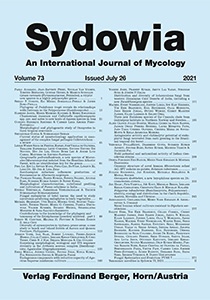
Genomic structure of novel Iranian Rhizoctonia solani AG-3PT isolates on potato, Solanum tuberosum Dorna Forghani, Eidi Bazgir, Mehdi Nasr Esfahani & Mostafa Darvishnia Sydowia 73: 217-238 Published online on February 10th, 2021 Rhizoctonia solani AG-3PT is relatively specific to potato, Solanum tuberosum, causing considerable yield losses around the globe, including Iran. A total of 210 R. solani isolates were collected from stem cankers and black scurf of infected potato plant parts in various potato-growing provinces of Iran, of which morphogenetic diversity of 110 R. solani isolates were characterized. High morphological and cultural variation was observed on radial colony growth and colour, hyphae diameter and number of nuclei, and sclerotia initiation, formation and diameter. The fastest mycelium growth rate was in non-pathogenic R. solani isolates. The pathogenicity and virulence characteristics of 70 R. solani isolates varied ranging from 0–100 % based on disease severity. There was no correlation between morphological factors, pathogenicity and geographic origin of the isolates. ITS-rDNA region barcoding of R. solani confirmed the isolates as R. solani AG-3PT. Nineteen polymorphic Inter Simple Sequence Repeat (ISSR) primers were used to reveal the genetic structure and relationships among 110 R. solani isolates, which 258 bands were detected. The average number of bands per primer was 21.5 and the size of the amplified DNA bands ranged from 100–5000 bp, with a high degree of polymorphism (100 %). The majority of the isolates showed nearby associations within the population. UPGMA classified the R. solani isolates into 16 main groups according to geographical origin, indicating that the ISSR marker is a reliable tool in characterizing genetic diversity in R. solani isolates. There was no correlation between ISSR analysis and virulence variability. Keywords: ISSR, ITS-rDNA, PCR, polymorphism, primer, UPGMA. |
 |